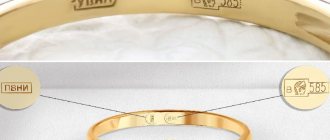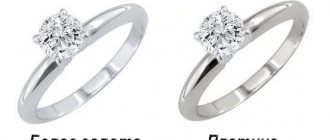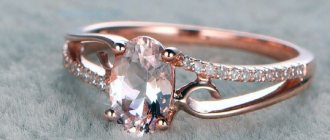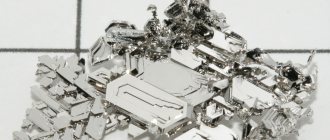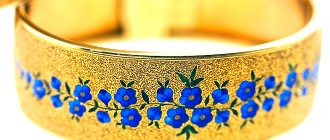Post updated: Jun 6, 2020
Almost everyone in school was told by their chemistry teachers about the incredible density of the yellow metal. And most of the students asked what is heavier, gold or its counterpart on the periodic table - lead? It is about 19.3 grams per cubic centimeter. Due to its chemical composition, gold does not enter into any reactions with the environment.
That is why it is so actively used in dentistry. This metal can be not only yellow. It depends on the components included in its composition. However, regardless of color, products made from this metal are incredibly popular.
The question arises, how does the density of gold compare to the density of other metals? Which element has the largest mass? This article can answer these and many other questions.
Top 10: The heaviest elements known to mankind
This basic list of ten elements is the heaviest in terms of density per cubic centimeter.
However, note that density is not mass, it simply measures how tightly packed the mass of an object is. Now that we understand this, let's take a look at the heaviest elements in the entire known universe.
10. Tantalum
Density per 1 cm³ - 16.67 g
The atomic number of tantalum is 73. This blue-gray metal is very hard and also has a super high melting point.
9. Uranium
Density per 1 cm³ - 19.05 g
Discovered in 1789 by the German chemist Martin H. Klaprot, the metal only became true uranium almost a hundred years later, in 1841, thanks to the French chemist Eugene Melchior Peligot.
8. Tungsten (Wolframium)
Density per 1 cm³ - 19.26 g
Tungsten exists in four different minerals and is also the heaviest of all elements and plays an important biological role.
7. Gold (Aurum)
Density per 1 cm³ - 19.29 g
They say money doesn't grow on trees, but the same can't be said about gold! Small traces of gold have been found on the leaves of eucalyptus trees.
6. Plutonium
Density per 1 cm³ - 20.26 g
Plutonium exhibits a colorful oxidation state in aqueous solution, and can also spontaneously change oxidation state and color! This is a real chameleon among the elements.
5. Neptunium
Density per 1 cm³ - 20.47 g
Named after the planet Neptune, it was discovered by Professor Edwin McMillan in 1940. It also became the first synthetic transuranium element from the actinide family to be discovered.
4. Rhenium
Density per 1 cm³ - 21.01 g
The name of this chemical element comes from the Latin word "Rhenus", which means "Rhine". It was discovered by Walter Noddack in Germany in 1925.
3. Platinum
Density per 1 cm³ - 21.45 g
One of the most precious metals on this list (along with gold), and is used to make almost everything. As a weird fact, all the platinum mined (every last bit) could fit in an average sized living room! Not much, actually. (Try to put all the gold in it.)
2. Iridium
Density per 1 cm³ - 22.56 g
Iridium was discovered in London in 1803 by the English chemist Smithson Tennant along with osmium: elements present in natural platinum as impurities. Yes, iridium was discovered purely by accident.
1. Osmium
Density per 1 cm³ - 22.59 g
There is nothing heavier (per cubic centimeter) than osmium. The name of this element comes from the ancient Greek word “osme”, which means “smell”, since the chemical reactions of its dissolution in acid or water are accompanied by an unpleasant, persistent odor.
Heaviest elements
The density of five elements was given above, of which platinum is the heaviest. However, it is not the heaviest element existing on earth. The density of the heaviest element is 22.61 grams per cubic centimeter. His name is Osmium.
Only this is not the limit of density. True, this element was created artificially in 1984. They named it Hassiy, its density is almost twice that of osmium.
Surprisingly, this is not a chapel either. There are materials many tens of times higher than the density of Hassia. However, they are in outer space. The matter contained in white dwarfs can have a density of up to 1000 tons per cubic centimeter. This news shocked the world community.
However, this is not the limit. Neutron stars contain matter with a density of about 500 million tons per cubic centimeter. This figure can easily be surpassed by the density of black holes, however, due to the difficulties of conducting research, this is only theoretical.
Rating of the heaviest metals in the world
Metals are an integral part of our life. People use them to make modern vehicles (cars, motorcycles, bicycles, etc.), household appliances, dishes and much more. In fact, they have become the basis of foundations in all spheres of human life: production, construction, medicine, etc. The scope of application depends on the metal itself and its properties, including gravity. Heaviness usually means the ratio of its mass to volume, that is, density. However, it is also possible to characterize metals by weight based on their relative atomic mass. Based on this characteristic, uranium and plutonium are the heaviest of all currently known metals.
If we consider density as a measure of determining gravity, then the ranking of the heaviest metals will be as follows:
10th place: Tantalum. Density 16.67 g/cm³.
Tantalum is a rare metal, bluish-gray, but more often lead-colored. It is very hard and refractory. However, despite the high melting point (3017 °C), tantalum remains very plastic, which is why it is easy to machine. Due to its physical properties, tantalum is widely used in the production of high-tech devices and equipment: capacitors, mobile devices, computer equipment, and in the military industry.
9th place: Uranus. Density 19.05 g/cm³.
In terms of relative atomic mass, uranium is the heaviest on the planet. The color of the substance is silver-brown or silver-white, glossy. Uranium is very malleable, flexible and dense. Widely used in nuclear reactors and in the production of nuclear weapons.
8th place: Tungsten. Density 19.29 g/cm³.
In addition to having one of the highest densities in the world, tungsten is characterized by high thermal and electrical conductivity, increased resistance to abrasion and acids. An exceptional feature of tungsten is its refractoriness. It has the highest melting point (3422 °C). Only carbon is higher. In this case, tungsten boils at 5555 °C. To understand the seriousness of these numbers: the surface temperature of the Sun is 5500 °C. In its pure form, tungsten is silvery-white and easily forgeable. It is a companion of tin ore, but when smelting tin, it turns it into slag foam, for which it was called “wolf’s cream.”
7th place: Gold. Density 19.29 g/cm³.
A precious metal, significant throughout the world. Historically, it has been bought and sold, and at one time it could even be killed for gold. Currently, gold is no less in demand, because the gold fund supports the country’s monetary well-being. The largest reserves of this metal are recorded in America. There is unlikely to ever come a time when gold will no longer be so in demand. Unless it is replaced by some other precious metal.
Fun fact: can anyone imagine that gold grows on trees? But it can! For example, a small amount of this precious metal is concentrated in the leaves of eucalyptus growing on gold-bearing soil.
6th place: Plutonium. Density 19.80 g/cm³.
Plutonium is the heaviest metal on earth and the most important substance in the production of nuclear weapons. This metal has an impressive color palette, because when oxidized (depending on the degree of oxidation and the acids themselves), it, like a chameleon, displays a color range from light purple, chocolate, to light orange or green.
5th place: Neptunium. Density 20.47 g/cm³.
The metal was first experimentally isolated in the first half of the 20th century by American researchers: chemist E. MacMillan and geochemist F. Abelson. It got its name from the eighth planet of the solar system - Neptune. Neptunium is obtained from the products of long-term irradiation of uranium in nuclear reactors during the synthesis of plutonium.
4th place: Rhenium. Density 21.01 g/cm³.
Another significant and rare, and therefore expensive metal. Rhenium was discovered in 1922 in Germany by German chemist couple Ida and Walter Noddack, who gave the metal its name in honor of the Rhine River.
Silver
Silver, like gold, has been known to mankind since ancient times. It is used not only in the manufacture of jewelry, but also for the production of tableware. Previously, silver was very actively used in coinage. And today you can see some coins containing a little silver. When choosing a precious metal, the question often arises: what is heavier, gold or another precious metal - silver.
The density of this metal is slightly less than that of lead. It is equal to 10.5 grams per cubic centimeter. This means that gold is almost twice as heavy as silver.
In addition to creating silverware and various jewelry, this material is very actively used in industry, as well as in the photographic industry.
The main properties due to which this element has become so widely used in the industrial field are excellent thermal and electrical conductivity, excellent resistance to interaction with the environment, as well as excellent reflectivity.
Rapidly developing technological progress has significantly reduced the use of silver in the photographic industry. This is due to the fact that thanks to the introduction of modern technologies, the process of producing and using photographic equipment has become much more accessible to most people. This is what ensured a reduction in the use of silver by more than 3 times.
Due to its bactericidal properties, this metal is very actively used in medicine. Currently, silver is used to produce antibacterial patches, as well as to produce filters for purifying water from harmful microorganisms.
Silver nitrate used in medicine.
The heaviest metals in the world
Humanity began to actively use metals back in 3000-4000 BC. Then people became acquainted with the most common of them: gold, silver, copper. These metals were very easy to find on the surface of the earth. A little later they learned about chemistry and began to isolate such species as tin, lead and iron. In the Middle Ages, very poisonous types of metals gained popularity. There was arsenic in use, which poisoned more than half of the royal court in France. So did mercury, which helped cure various diseases of those times, from sore throat to the plague. Already before the twentieth century, more than 60 metals were known, and at the beginning of the 21st century - 90. Progress does not stand still and leads humanity forward. But the question arises, which metal is heavy and weighs more than all the others? And in general, what are they, these heaviest metals in the world?
Many people mistakenly think that gold and lead are the heaviest metals. Why exactly did this happen? Many of us grew up watching old movies and seeing the main character using a lead plate to protect himself from vicious bullets. In addition, lead plates are still used today in some types of body armor. And when you hear the word gold, many people think of a picture of heavy ingots of this metal. But thinking that they are the heaviest is a mistake!
To determine the heaviest metal, one must take into account its density, because the higher the density of a substance, the heavier it is.
Osmium and iridium are the heaviest metals in the world
Let's look at the main heavyweights who share 1st and 2nd places. Let's start with iridium and at the same time say words of gratitude to the English scientist Smithson Tennat, who in 1803 obtained this chemical element from platinum, where it was present along with osmium as an impurity. Iridium can be translated from ancient Greek as “rainbow”. The metal is white with a silver tint and can be called not only the heaviest, but also the most durable. There is very little of it on our planet and only up to 10,000 kg are mined per year. It is known that most iridium deposits can be found at meteorite impact sites. Some scientists come to the conclusion that this metal was previously widespread on our planet, but due to its weight, it constantly squeezed itself closer to the center of the Earth. Iridium is now widely in demand in industry and is used to generate electrical energy. Paleontologists also like to use it, and with the help of iridium they determine the age of many finds. In addition, this metal can be used to coat some surfaces. But this is difficult to do.
Iridium
Next, let's look at osmium. It is the heaviest in the periodic table of Mendeleev, and, accordingly, the heaviest metal in the world. Osmium is tin-white with a blue tint and was also discovered by Smithson Tennat at the same time as iridium. Osmium is almost impossible to process and is mainly found at meteorite impact sites. It smells unpleasant, the smell is like a mixture of chlorine and garlic. And from ancient Greek it is translated as “smell”. The metal is quite refractory and is used in light bulbs and other devices with refractory metals. For just one gram of this element you have to pay more than $10,000, which makes it clear that the metal is very rare.
Osmium
Whatever one may say, the heaviest metals are very rare and therefore they are expensive. And we must remember for the future that neither gold nor lead are the heaviest metals in the world! Iridium and osmium are the winners in weight!
Characteristics and influence of the sample on weight
Gold and silver are noble metals, malleable, ductile, classified as precious, yellow and silver-white in color, respectively. They are well machined. Au is immune to chemical oxidizing agents, even the strongest ones. Only “royal vodka” (a mixture of acids) can dissolve it.
Separate assays for gold and silver are established and used. How pure an element is is easy to determine by testing:
- Thus, for Au, samples 375, 500, 585, 750, 958 are used (999 is pure). The higher the sample, the denser the alloy, and accordingly, the greater the weight. The less noble metal in the alloy, the lighter it is.
- For silver, the lowest grade is 720, the highest is 960. Alloys of different grades differ visually. The worse the sample, the less recognizable shine, the yellowness that is no longer characteristic of pure Ag.
Comparison with other metals
Gold and silver are interesting for their precious properties. However, they are primarily metals and have qualities comparable to their “brethren”.
Comparative table of gold and silver with other metal alloys
| Me/alloy | Characteristics | |||
| At. weight, a.m.u. | Melting temperature, ºС | Density, g/cm3 | Mohs hardness | |
| Gold | 197 | 1095 | 19,32 | 2,5-3 |
| Silver | 107,9 | 962 | 10,5 | 2,5-3 |
| Platinum | 194,8 | 1768 | 21,45 | 4-4,5 |
| Lead | 207,19 | 327,4 | 11,337 | 1,5 |
| Cast iron | — | 1150—1200 | 7,1 | 7,5 |
| Mercury | 200,59 | -38,83 | 13,5 | 1.5 (solid) |
| Copper | 63,54 | 1083 | 8,96 | 3 |
| Iron | 55,85 | 1535 | 7,87 | 4 |
| Steel | — | 600-1600 | 7,85 | 4-4,5 |
Platinum is the closest in terms of characteristics to gold and silver. Also applies to noble metals; in density and atomic mass it is close to Au, but more refractory. Platinum is somewhat similar to Ag in its silvery-white color.
In addition to alloys - cast iron and steel - the presented metals belong to the group of transition metals. The exception is lead - it is from the light Me group. Only two metals from the list are found in living organisms - iron (blood) and copper (liver).
Almost always, to obtain a pure substance it is necessary to isolate it from oxides or salts and process ores. And only Au is able to “reveal itself” in its pure form, occurring in the form of nuggets or sand. The heaviest metal compared is gold.
Also, watch an interesting video about how you can distinguish gold and silver from other metals.
Table of specific gravity of metal alloys
The specific gravity of metals is most often determined in laboratory conditions, but in their pure form they are very rarely used in construction. Alloys of non-ferrous metals and alloys of ferrous metals, which according to their specific gravity are divided into light and heavy, are much more often used.
Light alloys are actively used by modern industry due to their high strength and good high-temperature mechanical properties. The main metals of such alloys are titanium, aluminum, magnesium and beryllium. But alloys based on magnesium and aluminum cannot be used in aggressive environments and at high temperatures.
Heavy alloys are based on copper, tin, zinc, and lead. Among the heavy alloys, bronze (an alloy of copper with aluminum, an alloy of copper with tin, manganese or iron) and brass (an alloy of zinc and copper) are used in many industries. Architectural parts and sanitary fittings are produced from these grades of alloys.
The reference table below shows the main quality characteristics and specific gravity of the most common metal alloys. The list provides data on the density of the main metal alloys at an ambient temperature of 20°C.
Admiralty Brass - Admiralty Brass (30% zinc, and 1% tin)
Aluminum bronze - Aluminum Bronze (3-10% aluminum)
Source
Specific gravity of precious metals and how it affects the price
Gold is an extremely malleable and malleable metal; from 1 gram of gold you can stretch a thread 2 km long. Silver is a champion in electrical and thermal conductivity. Platinum is durable, hypoallergenic and practically eternal; it lasts for thousands of years in conditions in which other metals rust and crumble to dust. All these metals are different; they differ in flexibility, strength, weight and, accordingly, price.
Why do three absolutely identical jewelry made of gold, silver and platinum weigh differently? What is specific gravity and specific gravity of precious metals? Zlato.ua is not a physics textbook, so we will try to explain everything in the simplest and most understandable language possible.
What is specific gravity?
Today we are talking specifically about noble (precious metals). There are only four of them used in jewelry:
- Gold;
- Platinum;
- Silver;
- Semi-precious copper.
Let's start with the fact that all metal products that have the same volume, but cast from different metals have different masses. The weight of the product directly depends on its volume. In other words, the ratio of the volume of the alloy to its mass (kg/m3) is the specific density . Specific gravity is the same as density. That is, a quantity that is the ratio of weight to volume. Calculation formula: Y=P/V, where P is weight and V is density.
Metals in their original form are almost never used in jewelry. The likelihood of encountering jewelry made of pure gold is negligible. Why? Because it's impractical. Pure metal is too soft; if you pour jewelry out of 100% gold, it will bend and deform. Therefore, each of the precious metals requires improvement. To increase strength and wear resistance, add shine and change the shade, jewelers use ligature , that is, impurities. An alloy with added impurities has a different specific gravity, which differs from the specific gravity of pure gold, silver and platinum.
The following is used as a ligature:
- copper;
- nickel;
- silver;
- zinc;
- palladium;
- indium;
- germanium.
Density tables for metals and alloys
All metals have certain physical and mechanical properties, which, in fact, determine their specific gravity.
To determine how suitable a particular alloy of ferrous or stainless steel is for production, the specific gravity of rolled metal is calculated. All metal products that have the same volume, but are made from different metals, for example, iron, brass or aluminum, have different mass, which is directly dependent on its volume. In other words, the ratio of the volume of the alloy to its mass—specific density (kg/m3)—is a constant value that will be characteristic of a given substance. The density of the alloy is calculated using a special formula and is directly related to the calculation of the specific gravity of the metal. The specific gravity of a metal is the ratio of the weight of a homogeneous body of this substance to the volume of the metal, i.e. this is density, in reference books it is measured in kg/m3 or g/cm3. From here you can calculate the formula for finding out the weight of a metal. To find this you need to multiply the reference density value by the volume.
The table shows the densities of non-ferrous metals and ferrous iron. The table is divided into groups of metals and alloys, where under each name the grade according to GOST and the corresponding density in g/cm3 are indicated, depending on the melting point. To determine the physical value of specific density in kg/m3, you need to multiply the tabulated value in g/cm3 by 1000. For example, this way you can find out what the density of iron is - 7850 kg/m3.
The most typical ferrous metal is iron. The density value of 7.85 g/cm3 can be considered the specific gravity of iron-based ferrous metal. Ferrous metals in the table include iron, manganese, titanium, nickel, chromium, vanadium, tungsten, molybdenum, and ferrous alloys based on them, for example, stainless steel (density 7.7-8.0 g/cm3), black steel ( density 7.85 g/cm3) is mainly used by manufacturers of metal structures in Ukraine, cast iron (density 7.0-7.3 g/cm3). The remaining metals are considered non-ferrous, as well as alloys based on them. Non-ferrous metals in the table include the following types:
− noble metals (precious) - platinum, gold, silver and semi-precious copper;
− low-melting metals – zinc, tin, lead.
Specific gravity of gold, silver and platinum
The sample depends on the amount and composition of impurities in the product. Fineness is the amount of pure precious metal in an item. For example, in the 585 sample of gold, the pure metal indicator is 58.5%. The remaining 41.5% is an admixture of other metals.
Specific gravity of pure gold -
19.32 g/cm3. The most common gold standard is 585. The specific gravity of gold 585 ranges from 12.85 g/cm3 to 14.76 g/cm3, depending on the shade and composition of impurities. White gold has an even lower density, because the noble white color is derived from a mixture of ordinary yellow gold with a large amount of silver.
Melting point of gold - 1,064°C
Specific gravity of pure silver
- 10.5 g/cm3. Silver is harder than gold, but more ductile - it is easier to process, which indicates less wear resistance of this metal. Silver jewelry is easier to scratch and bend. The most common standard of silver for jewelry is 925.
Melting point of silver - 961.8°C
Specific gravity of pure platinum
- 21.45 g/cm3. Platinum is the strongest jewelry metal, so it does not require a large amount of ligature. The most common standard of platinum for jewelry is 950, that is, almost “pure”. Its specific density is 21.05 g/cm3.
The melting point of platinum is 1769° C
Can osmium stop a bullet?
Osmium is extremely hard, no less hard than the steel of the barrel you are using. ...Osmium is so hard (almost as hard as diamond) that if you try to force it into a narrower rifling space, you might just break the bullet because it is also very brittle.
Related Posts:
- Why do alkali metals have the largest atomic radius? What are the 10 heaviest metals? What are the top five strongest metals? What are the three lightest alkali metals? Which alkali metal is the smallest in size? Do metals have the largest atomic radius?
Platinum group metals
Palladium is a silvery-white metal whose color closely resembles platinum. The density of palladium is 12.16 g/cm. Melting point - 1554.5°C. Palladium has good malleability and ductility, but its wear resistance is worse than that of platinum. For the manufacture of jewelry, an 850-carat palladium alloy is usually used, where 85% palladium, 13% silver and 2% nickel.
Rhodium is a pale blue metal with a density of 12.4 g/cm3. Melting point - 1966° C. Rhodium is actively used in jewelry to coat silver and white gold jewelry. The thinnest layer is applied electrolytically, enhancing shine and protecting the product from tarnishing.
Uses of gold
The demand for the yellow metal determines not only its use in the production of jewelry and the increase in the state’s gold and foreign exchange reserves. It is also very widely used in many other areas.
In industry, gold began to be actively used due to its chemical properties. It covers mirrors operating in the far infrared range. This is especially useful when conducting all kinds of nuclear research. Gold is also very often used for soldering components made of various materials.
Another area of application is dentistry. This is due not only to the impossibility of the yellow metal entering into a chemical bond with the human body, but also to its incredible corrosion resistance.
Pharmacology also cannot do without the use of this amazing yellow metal. Gold compounds are now actively used in various medical preparations that save from a wide variety of diseases.
These are not the only uses for gold. Due to rapid progress, there is an increasing need to use gold content in technological innovations. From this we can conclude that yellow metal is not only an attribute of luxury, but also a useful technical tool, the importance of which is increasing every year.
The density of metals is shown in increasing order:
That is why three jewelry made of gold, silver and platinum, absolutely identical in area and volume, weigh differently. The denser the material, the more it is needed. This point should be taken into account by everyone who is going to place an individual order for the manufacture of jewelry - not only the price per gram of the precious metal plays a role, but also its specific gravity.
Now you know what it is and can avoid an unpleasant surprise when announcing the price. Stay with Zlato.ua, we are preparing many more useful life hacks for you!
Click to read older material!
Have you seen a stunning ring in white gold and want to order the same, but in a red shade of the metal? Or would you like to make your favorite model of classic 585 wedding rings from platinum? Modern jewelers create jewelry for every taste: in a wide palette and design. But very often the price of a custom-made product comes as a surprise and exceeds expectations. Here, not only the price of the precious metal per gram plays a role, but also its specific gravity. What is this characteristic and why know, if not its formula, then how it affects the price? Zlato.ua experts will easily talk about complex things and explain why externally identical products have different weights?
Gold necklaces of the same design have different weights and prices
What is the specific gravity of a precious metal
Specific density (kg/m3) is the ratio of the volume of the alloy to its mass.
Specific gravity is the weight of a unit volume of an unconditionally dense (non-porous) metal. This is the ratio of weight to volume of the metal in its pure form. Formula: Y=P/V, where P is the weight of the element, V is the density.
It is impractical to use metals in their pure form to make jewelry. For example, gold and silver are too soft for this. Each of the precious metals requires improvement: to increase its strength and wear resistance, to change its shade. All these procedures affect the sample and, as a result, the price of the finished product.
Fineness is the amount of pure precious metal in an item. For example, in the 585 sample of gold, the pure metal indicator is 58.5%, the rest is a ligature. Alloys with the addition of other metals have their own specific gravity, which differs from the specific gravity of pure gold, silver or platinum . Copper, nickel, zinc, silver, palladium, indium, and germanium are used as additives. After this, the characteristics of the metal change: from melting point to density.
A ring of the same size with the same parameters made of gold, silver and platinum will have different weights. When making custom jewelry, you should take this into account.
Ring in white gold, yellow and platinum
Platinum
This element has been known since time immemorial, but in Europe, in its pure form, it was obtained at the beginning of the 19th century. Platinum is a noble metal whose value used to be 2.2 times that of gold. This was due to the very small amount of platinum in the world. There are about 30 grams of platinum per kilogram of the yellow metal. At this point in time, the cost of gold is noticeably higher. This is due to the chemical and physical properties of the metal.
Platinum is a white-silver metal of extraordinary beauty, which, like gold, occupies a leading place among metals. The most important feature of this metal is its strength. Therefore, platinum jewelry does not wear out. In Russia, the following hallmarks of platinum exist: 950,900, 850. Platinum jewelry contains about 95% pure platinum, and a gold item contains 750 hallmarks, 75% gold.
Due to its high content, this metal is almost impossible to scratch. This is why it is so widely used in industry. But with gold it’s a completely different story. Another reason is the fact that all countries' gold and foreign exchange funds consist of gold. This practice has evolved over centuries and now it is simply pointless to spend decades reforming a well-functioning system.
It is surprising that platinum, at a certain period of time, was considered waste from gold mining, which was immediately thrown away.
Having assessed the density of the above metals, I wanted to know what would be heavier, gold, which will remain the unsurpassed leader, or platinum. The density of platinum is 21.45 grams per cubic centimeter. From this we can conclude that platinum is heavier than the yellow metal. Therefore, jewelry made of platinum weighs more than jewelry made of gold.
Density of gold, silver and platinum
The specific gravity of pure 999 gold is 19.32 g/cm3, and there are only 0.01% of impurities in it. For 585 standard, this means that there is 58.5% gold, and 41.5% other metals (which were added for hardness and shine of the jewelry). The added metals have a different density than gold.
585 gold has a density from 12.85 g/cm3 to 14.76 g/cm3 depending on the shade and composition of the alloy (white has a lower density). This means that a gold bar weighs 12.85 times more than an equal volume of water. The density of liquid gold is less than solid gold and is 17 g/cm3.
A ball made of pure gold (999 fine) with a diameter of 46.237 mm weighs one kilogram. A two-liter plastic bottle with gold sand weighs about 32 kg
Density of gold depending on the shade of the alloy
Density of pure silver
– 10.5 g/cm3. It is harder than gold and heavier than steel. Silver can be easily processed, but this also reduces its wear resistance. Copper is added to it for strength. Standard silver for jewelry is 925.
Silver bars of 1 kilogram are larger in volume than gold bars
Platinum is the hardest and most durable material. The metal is difficult to process, but, for example, the prongs in a ring made of it that hold the stone do not become loose. 999 sample has a density of 21.45 g/cc. 950 standard platinum in jewelry has a total specific gravity of 21.05 g/cc.
In the production of jewelry, the proportion of platinum ranges from 85% to 95%. This means that the product is almost entirely made of precious metal.
Example: three smooth rings, absolutely identical in volume and area, without inserts, rings made of silver, gold and platinum will have different weights. Platinum is denser than white gold, so it will take more platinum to create identical wedding rings, which will affect the price.
Those who want to order a gold ring made of gold based on a platinum prototype should take into account that in the modern precious metals market, since 2015, the first metal has been ahead of the price of the second by $10 per gram. This is worth knowing when calculating the price.
What kind of jewelry is made from platinum?
Platinum is the most wear-resistant metal with anti-corrosion properties, representing a symbol of hardness and reliability. Imagine platinum wedding or engagement rings - timeless, like the deepest love.
photo of platinum jewelry
The big disadvantage of jewelry made from this alloy is its high cost; if we compare similar products made from white gold and platinum, the latter will be about three times more expensive. It is no coincidence that a comparison is made between these two metals, since they are very similar in appearance. It was the demand for white gold that gave rise to such popularity of platinum.
It is worth mentioning separately the combination of platinum and diamonds. Only such a gray-white frame can emphasize the depth and transparency of the stones. It’s not for nothing that before platinum and white gold became famous, diamonds were set in silver. And given the natural hardness of platinum, you will always know that the “stones” are always well secured in the ring. Such decoration can emphasize a high level of well-being and self-confidence.
Platinum Ingot
The jewelry industry is not the main one for this precious metal. In medicine, platinum is used to make electrodes for patients with angina pectoris, and is used in dentistry and in the treatment of cancer. It is also used to make mirrors for laser technology and to produce stable and durable electrical contacts.

